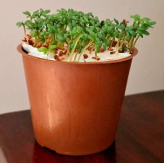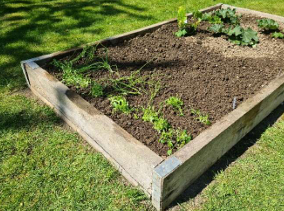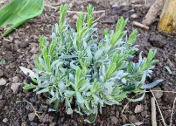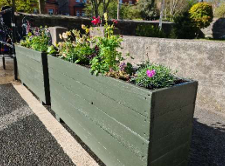Rev David White sent us this report:
‘Green Zion’ is an exciting new environmental project shared between the children of Zion Church of Ireland Parish Sunday Club and Zion Parish Primary School. We are all part of the same campus here in Rathgar, Dublin 6, and many children are part of both communities.
We have found lots of resources to help us with our learning and practical work over the past few months.
Having Fun with Microgreens

Junior and Senior Infants had fun growing some microgreens on cotton wool in small pots made from recycled plastic. Microgreens are, as the name suggests, plants that are harvested when still small and green. They are very nutritional and full of flavour. We chose cress as it is fast growing and a lovely addition to most meals. Resource: Kids Gardening
(www.kidsgardening.org)
Growing your own Food: Sowing Seeds & Planting Plug Plants

First and Second Classes were out in the raised beds where they direct sowed some vegetable seeds including, Swiss Chard, Radish and Scallion. They also planted some Lettuce as plug plants. These are young plants that are not as small as a seed, or a seedling, and not as big as a mature established plant. They were grown in a plug tray which is made up of individual cells each filled with a little plant. The benefit of planting this way is that it gives the plant a head start and it also means that they’re a little stronger if slugs or snails decide to nibble on them. Resource: Grow It Yourself (www.giy.ie)
Feeding the Bees

Sunday Club, as well as Third and Fourth Classes, learned about the importance of bees in our world. In order to produce seed and reproduce, plants have to find a way for pollen to get from one flower to another. The amazing resources from the National Biodiversity Data Centre are a great way to learn all about this. In one of the Guides they say, ‘This movement of pollen is called pollination. Without it, there would be no seeds, and without seeds, there would be no plants.’ Both classes planted the tree Amelanchier × grandiflora ‘Ballerina’ (Serviceberry/Juneberry) and some other pollinator friendly perennial plants: Scabious, Lavender, Lesser Periwinkle and a White Carpet Rose. Resource: How-to-guide: Develop a
Pollinator Plan (www.pollinators.ie).

Growing your own Food: Tubers & Herbaceous Perennials

Fifth and Sixth Classes discussed growing potatoes in their own gardens. These tubers can be grown in containers, raised beds or the open ground. They then planted the variety ‘Home Guard’ in the raised beds. It is an early potato, and they are looking forward to eating them
in class twelve weeks after planting. As dessert they planted rhubarb (‘Timperely Early’), but this cannot be eaten in the first year as it would weaken the young plant. Next year it will be ready for making crumble. Rhubarb is an herbaceous perennial which simply means that it will live for a number of years and that the foliage dies back in the Winter. Resource: RHS (Royal Horticultural Society) Gardening for Schools and Children (www.rhs.org.uk)
